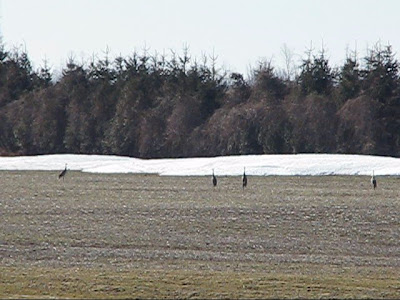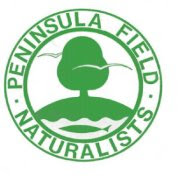Saturday, March 21, 2009
First Day of Spring & Shade-Grown Coffee
Car pooling on a recent OFO trip contributed in the reduction of carbon emissions but what else could we do that would be beneficial, especially with it being the first day of spring? I had recently found some information on shade-grown coffee while browsing the web. Originating at the blog, Birding with Kenn & Kim, I found my way to the Birds and Beans site for Canadians and discovered a list of shade-grown coffee distributors. To my surprise, a small restaurant in downtown St. Catharines was on the list. Perfect! Not only could we purchase shade-grown coffee, it was also found within walking distance of our home. Though not planned we had lunch at the restaurant on Friday, followed by a cup of coffee. It was excellent and a 1/2 pound of the Birds and Beans Sumatra blend was purchased. This morning's cup was really good, so future purchases will occur. With only the Sumatra beans available downtown, Central and South American blends will have to be purchased online. After an early morning cup of Guatemalan Huehuetenango, Jean and I can observe warblers this spring knowing we have contributed to the conservation of their winter homes.
A quick visit to Jaycee Park in honour of the March equinox produced two additions to the year list. A Pied-billed Grebe (#72) was observed on Martindale Pond as well as a Double-crested Cormorant (#73). Yes, spring has finally arrived in southern Ontario.
Thursday, March 19, 2009
Long Point OFO Trip
A scan of the Wood Duck houses for screech owl proved unsuccessful but an immature Bald Eagle (#66) flew through the trees to the delight of the group. Shortly after that observation a Great Blue Heron, another first for 2009 (#67) was seen flying above our location.

Images courtesy of Annie Goulden
After viewing the cranes, our attention was drawn to the gulls that other members of the group were observing. Many thanks to Steve Thorpe for finding the Glaucous Gull (#69), amongst the Ring-billed Gulls, through the heat haze on a flooded field. In addition, 2 Killdeer (#70) were observed during our time at Lee Brown's.
We proceeded to 1st Concession Road to look for waterfowl on the same creek visited earlier in the morning. No new species observed here. It was time for lunch, so the group headed for the Old Cut Banding Station on the point. Bird Studies Canada had kindly opened the station to allow the OFO group a spot to have lunch.
After eating and a quick review of the species tallied so far, we walked the trails adjacent to the banding station. Walking the trails our gang of four observed, Black-capped Chickadee, Mourning Dove, Red-winged Blackbird, Northern Cardinal, American Robin, Common Grackle, American Crow, American Tree Sparrow, Song Sparrow and Dark-eyed Junco. Unfortunately for us we did not see the Golden-crowned Kinglet observed by a few other OFO birders. The remains of a large avian carcass was found on the trail and it appeared to be that of a Great Blue Heron. Before returning to the mainland our group stopped at a viewing stand on the causeway to view the waterfowl on the inner bay. Room was limited on the viewing stand so a small group of us stood on the shoreline to obtain this view of the inner bay.
Image courtesy of Annie Goulden
Behind the waterfowl, 8 immature Bald Eagles played and provided the afternoon's entertainment to some OFO members. The large amount of Tundra Swans took flight and revealed approximately 50 Snow Geese. The sight was pretty cool.
Image Courtesy of Annie Goulden
The last stop for our carload was on Concession Road #3 along Big Creek. Green-winged Teal (#71), our last species to add to the year list, were observed with Northern Pintail, American Wigeon and Ring-necked Duck. The train of cars continued along more concession roads in search of Golden Eagle but we decided to call it a day, visiting Booth's Marina before returning to our car at the forestry station. No waterfowl were observed at the marina. No Golden Eagle either as per Jim's trip report on the listserve. We missed the Eastern Bluebirds listed on the report but I can tick them later. We have promised to take Jean's mum to search for Eastern Bluebird. We have a couple of spots lined up that should produce positive results.
Overall, Jean and I had a great field trip, adding 12 species to the year list. Thanks to Annie and Bev for inviting us along for the drive through the Long Point area. We enjoyed their company and appreciated their knowledge of the area. We have promised to return the favour if they decide to attend the Niagara River OFO trip even though it is in December and will be much colder (especially at Adam Beck). Additional thanks to Annie are in order for providing the images appearing on this post. Glad to see she captured one of Jean and I in our designer rubber boots. This was our first visit to Long Point and it will not be our last, perhaps a future visit to observe warblers will occur.
Oh and for those interested, Liverpool FC 4-Man. Utd. 1. Nuff said!
Thursday, March 12, 2009
Bear Tagging in Algonquin with Rick Mercer
http://www.cbc.ca/mercerreport/video.html?maven_playerId=rmrseason6player&maven_referralParentPlaylistId=cf8422db32d35135bba4cbab1e5b6e2ad943cffd&maven_referralPlaylistId=bb1a3b078c3be69fa0d585c430c0ba69432864a1&maven_referralObject=1058122567
Wednesday, March 11, 2009
Winter Listing
Since we started birding the number of lists that I keep has increased with the passing of every year. In 2008, two checklists were added. During a family vacation in Algonquin Provincial Park, I picked up a checklist for the park at the west gate welcome centre.
Birding Woodland Cemetery, OFO Convention
Back to winter listing (December 1 to February 28), I'm not sure if it exists south of the Canadian border, a web search only found provincial winter lists. "Are there any U.S. compilers keeping winter lists, perhaps in the northern States?".
During the 2008/2009 winter birding season 197 species were observed in the province of Ontario. Jean and I observed a total of 73 species. Reviewing our observations (2006/2007, 2007/2008 and 2008/2009) through eBird Canada, the number of species observed has increased every season. Hopefully with a bit of luck and some effort on our part, a greater number of species will be observed during the 2009/2010 winter birding season.
If I come up with any new lists between then and now I'll let you know.
Two additions to the year list occurred Sunday. Returning home in the afternoon, 2 Turkey Vultures (#58) were observed soaring over the neighbourhood. Later that evening, 5 Wild Turkeys (#59) were seen roosting in a tree for the night while we were travelling to my brother-in-law's for a visit.
Saturday, March 7, 2009
Reflections & Deletions

It was not until 2006 that I thought we should truly start maintaining lists of birds we encounter. Two of the observations in question are from our first year of birding.
The first bird in question is a Barrow's Goldeneye observed on 12 Mile Creek in February of 2006. We both cannot say for certain that we actually observed a Barrow's. Head colour was used in the identification but more attention to detail should have occurred. I did not let the inquiry from a regional reviewer, a highly experienced birder, intimidate me. I was not offended either. They have a job to do. Simply put, the experienced we have gained had us questioning ourselves.
The second observation in question was a male Harlequin Duck we found in Dufferin Islands in March of 2006. This one I'm keeping on the list. There is no doubt in our minds that this was a Harlequin Duck. It was considerably smaller than the many Mallards in the pond. The body was bluish gray with chestnut flanks and on the head, the white patch near the ear and the white crescent in front of the eye were very visible. The duck had all the markings of a breeding male Harlequin.
In late May of 2007, we thought we had observed a Worm-eating Warbler exploring the branches of a Walnut tree in our neighbour's yard. That would be freaking awesome if indeed it was a Worm-eating Warbler. Once again, with the experienced gained we have concluded that we most likely observed a Red-eyed Vireo. Spring appearances of Worm-eating Warblers in this area are very rare. The northern extent of the breeding range is found south of Ontario. Since 1956 only 24 Worm-eating Warblers have been observed in the Hamilton Study Area and the Niagara Region would have comparable data.
I am eagerly awaiting the publication of John and Kayo's book "Niagara Birds". It will be great to have a regional bird book sitting next to Bob Curry's book "Birds of Hamilton and Surrounding Areas" on our book shelf.
On March 15 of last year a visit to Jaycee Park in St. Catharines produced two observations that attracted the attention of the regional reviewer. From the park, an Eared Grebe was observed on Martindale Pond. The grebe we observed had a dark cheek and neck as opposed to the white cheek and throat of a Horned Grebe. The grebe also had a thin neck and a more pronounced crown. Thus I fully support our submission of Eared Grebe.
The second bird observed that day was a Ruby-crowned Kinglet. It was observed in a stand of coniferous trees with Black-capped Chickadee, Red-breasted Nuthatch, and White-breasted Nuthatch. Two white wing bars, a white eye ring and no apparent coloured crown were identified on this small bird. Though it was early in the year (the weather was mild that day) I still stand with my final answer of Ruby-crowned Kinglet.
The last observation in question is a Lesser Black-backed Gull found on the Lake Erie shore on August 31 of last year. Jean and I travelled to Morgan's Point Conservation Area to observe shorebirds. On the limestone shore, amongst some Herring, Bonaparte's, and Ring-billed Gulls was 1 Lesser Black-backed Gull. Size comparison of the gulls aided in the identification. It was not the largest gull present. The yellow legs, dark gray back and a yellow bill with a red spot on the lower mandible sealed the i.d. for a Lesser Black-backed Gull.
Of the discussed observations, the Barrow's Goldeneye and Worm-eating Warbler were lifers. Reflecting on these observations, I don't feel comfortable with keeping them on our life list. So the list is reduced by 2 to 253. Hey, no worries! It'll make the next time we actually observe these birds all the more worth while.







